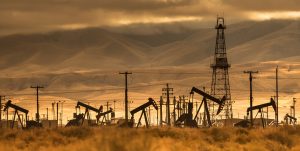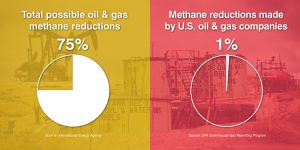
New EPA data confirms methane emissions not declining fast enough
Last week EPA released its annual data from large emitters, called the Greenhouse Gas Reporting Program (GHGRP). It is not a comprehensive account of all methane emissions (for that, check out our methane synthesis paper published earlier this year) but it does provided us with an important snapshot of 2017 oil and gas methane emissions.
Reduction trend not nearly enough
The Greenhouse Gas Reporting Program provides insights of trends in emission trajectories, especially in specific states and regions.
A look at those trends shows we are not cutting oil and gas methane emissions nearly fast enough to help avoid the most catastrophic impacts of climate change, a fact that was reinforced by the recent IPCC special report on global warming.
Specifically, the GHGRP found large oil and gas facilities reported emitting 3.5 million metric tons of methane in 2017. Although reported methane emissions declined about seven percent from 2016 to 2017, emissions remain high for many segments, particularly onshore production, which declined by less than one percent to 1.8 million tons.
The GHGRP also found total emissions from the oil and gas industry, including carbon dioxide and nitrous oxide, increased about one percent during that time period.
It is important to remember that the GHGRP is not a comprehensive estimate of methane emissions. First, it excludes facilities under the reporting threshold, which means the vast majority of operators do not report their emissions. Second, the GHGRP requires operators to estimate emissions with methods that mainly rely on bottom-up approaches such as emission factors. Several published studies have compared top-down and bottom-up estimates to demonstrate that GHGRP methods tend to underestimate emissions. (Learn more about top-down v. bottom-up measurements here.)
Trump policies mean more emissions
These numbers are from 2017, and therefore should include over five months of compliance with EPA’s methane pollution rules for new and modified facilities.
Unfortunately, any small downturn in emissions seen here could be wiped out by the Trump administration’s ongoing effort to roll back these rules. American communities – and our climate – need more protection from oil and gas pollution, not less.
A deep dive into the numbers
While the topline onshore oil and gas methane emissions numbers were similar to last year, breaking down the numbers shows some concerning trends.
Emission estimates from completions (gas flowback after hydraulically fracturing a well) and workovers (refracturing a well) emissions increased 93 percent from the year before. This counters an earlier trend showing a promising decrease in completion emissions, following 2012 rules from EPA requiring companies to reduce emissions during completions, known as ‘green completions.’ While some of the increase is due to more wells being completed in 2017, there was also increase in the average emissions per completion, which may indicate companies are less effective with their controls.
Associated gas venting and flaring, the waste of gas from co-producing oil wells, also increased from 2016 to 2017. In most basins, operators decreased the amount of wasted gas, but the two basins responsible for 80 percent of these emissions, the Permian and Bakken, had a one-third increase. It is critical for operators in these highly active regions to decrease flaring and venting, that includes taking steps such as installing adequate gas gathering infrastructure before drilling wells.
The oil and gas industry needs to get their emissions under control, and that means way down, if the industry is going to stay competitive in today’s energy landscape. Unfortunately, both the Trump administration proposal to gut methane rules and these new GHGRP data show the industry has a long way to go.
New EPA data confirms methane emissions not declining fast enough Share on X










